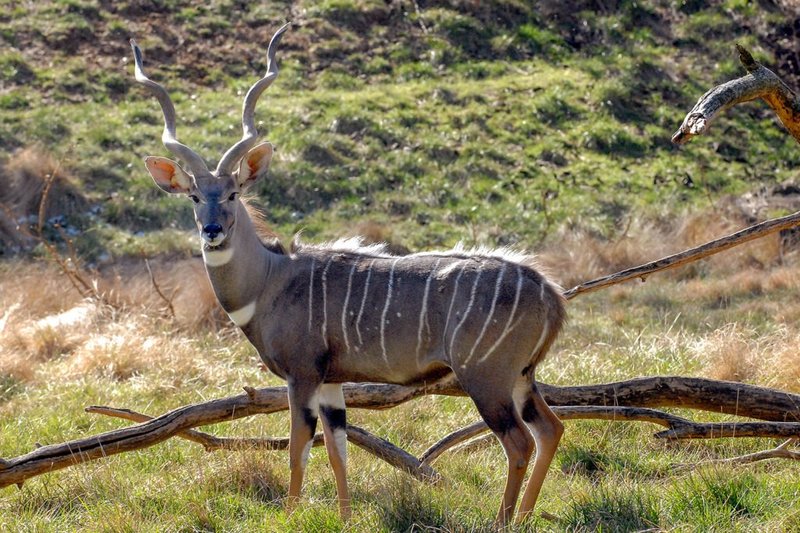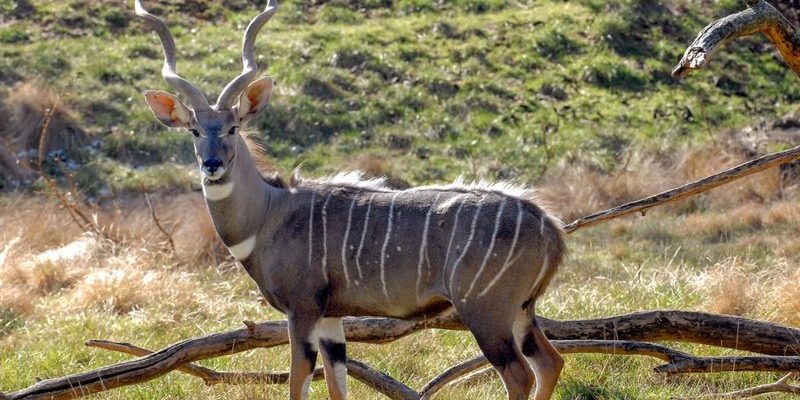
Imagine sitting on a sunlit savannah, sipping your favorite drink, and suddenly spotting a lesser kudu munching on leaves. It’s a reminder of how diverse our planet is and how many unique ecosystems exist. In this article, we’ll dive into the world of lesser kudus, exploring their habitat, distribution, and some fascinating facts about these elusive antelopes.
Understanding Lesser Kudus
Lesser kudus (*Tragelaphus imberbis*) are medium-sized antelopes known for their striking spiral horns and elegant, slender bodies. They’re a bit smaller than greater kudus, standing about 3 to 4 feet tall at the shoulder and weighing between 80 to 100 pounds. Their coats are a beautiful mix of reddish-brown with white stripes and spots, which helps them blend into their surroundings.
These animals are shy and prefer to stay hidden in dense vegetation. They’re more active during early mornings and late afternoons, which is when you might have the best chance of spotting one. By understanding their behavior and habitat preferences, you can appreciate how these creatures thrive in their environment.
The Natural Habitat of Lesser Kudus
You might wonder what kind of places lesser kudus call home. Generally, they inhabit thick bushland, open woodlands, and scrubby areas where they can find plenty of cover and food. They especially like areas that are close to water sources, as they need to drink regularly. This balance of dense foliage and open ground is crucial for their survival.
When lesser kudus browse, they often feed on shrubs, leaves, and fruits. They’re selective eaters, meaning they prefer certain plants. This helps them maintain a healthy diet while also playing a role in their habitat. Less-than-ideal conditions, like drought or human encroachment, can affect their food sources, so their habitat needs to be protected.
Geographical Distribution of Lesser Kudus
Lesser kudus are primarily found in East Africa, with their range stretching from southern Somalia down through Kenya and into Tanzania. They also inhabit parts of Angola and even head south into Namibia. This distribution means that the climate and environment can vary significantly depending on where they are.
In Kenya, for example, you might find them in the lush, dense forests of Mount Kenya, while in Tanzania, they’re often spotted in areas like Selous Game Reserve. Each region provides unique challenges and opportunities for lesser kudus, influencing their behavior and lifestyle in different ways.
Behavior and Adaptations in their Habitat
So, how do lesser kudus adapt to their environments? For one, their incredible camouflage helps them evade predators like lions and leopards. Their brown coats blend seamlessly with their surroundings, allowing them to be almost invisible when they stand still.
Additionally, these antelopes are excellent jumpers. They can leap up to 6 feet in the air! This skill comes in handy when escaping from threats. They also have a knack for navigating through thick underbrush, making it a challenge for predators to catch them. Lesser kudus truly showcase how nature equips animals with the tools they need to survive.
Impact of Human Activity on Their Habitat
Human activity poses a variety of challenges to lesser kudus. As urban areas expand and agricultural land increases, the natural habitats of these antelopes are shrinking. Deforestation and land development often lead to habitat fragmentation, which can isolate populations and make it harder for them to find food and mates.
Conservation efforts are crucial for protecting lesser kudus. Organizations are working to establish protected areas and create awareness about the importance of conserving these beautiful creatures and their habitats. Supporting local conservation initiatives can help ensure that lesser kudus continue to thrive in the wild.
Conservation Efforts for Lesser Kudus
Fortunately, there are several conservation programs aimed at preserving lesser kudu populations and their habitats. Protected areas like national parks and reserves play a significant role in safeguarding these animals. For instance, places like the Kruger National Park in South Africa and Tsavo National Park in Kenya help provide safe spaces for lesser kudus and other wildlife.
Community involvement is also a key component of conservation efforts. Educating local communities about the importance of wildlife and the benefits of ecotourism can help shift perspectives. By showing how preserving habitats can lead to sustainable livelihoods, we can foster a sense of stewardship that benefits both local people and wildlife.
Lesser kudus are remarkable creatures that showcase the beauty and complexity of Africa’s ecosystems. Understanding where they live and how their habitats function is essential for their survival. As we’ve explored, their habitats are influenced by a variety of factors, from food availability to human impact.
By protecting these environments and supporting conservation efforts, we can ensure that lesser kudus continue to roam the landscapes of East Africa for generations to come. So, next time you think of lesser kudus, you’ll have a better picture of their world—a world that reminds us of the delicate balance between nature and humanity.

